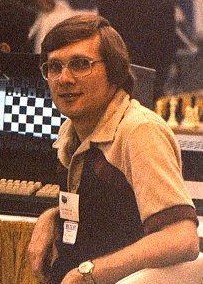- unknown (b.)
Bio/Description
An American computer scientist and microcomputer chess pioneer. Born in Decatur, Illinois, his interest in math became apparent in high school. He attended a special community college course where he took calculus. He majored in mathematics at San Diego State College, turning to computer programming after graduation in 1965. In 1974, he met his wife Kathleen (Kathe) at Southland Distributors, in Burbank, California. He was working for Sperry-Univac, as a programmer and was installing a new program system for the warehouse at Southland. With his wife Kathleen (Kathe), he started chess programming in 1977 on a Z-80 based Wavemate Jupiter III in assembly language. Their first program, Sargon had a one or two ply search without quiescence but exchange evaluation. After the success at The Second West Coast Computer Faire MCCT in March 1978, and the shared third place at ACM 1978, he and his wife became professional computer chess programmers. Sargon II was ported to various early home computers, for instance TRS-80 and 6502 based Apple II, as well as dedicated units such as the Chafitz ARB Sargon 2.5, the first commercial dedicated chess computer with an Auto Response Board (ARB). The Chafitz ARB Sargon 2.5, manufactured by Applied Concepts and distributed by Chafitz and Sandy Electronic, was launched in 1980 to became a milestone for electronic chess computers and starts the era of sensory board chess computers. The computer participated at the ACM 1979, and the WMCCC 1980, competing with four other Sargon incarnations and finished 8th of 15 with 2? out of 5. They first started selling their well commented Sargon I Z-80 assembly listing as paper copy for fifteen dollars on their own, and then contracted with Hayden Books to publish a book about Sargon. Hayden Software remained the primary distributor of all further Sargon software versions. He and his wife then signed a contract to work for the Miami based company, Fidelity Electronics; the makers of the Chess Challenger, an automated chess board game to develop updated software for that program. They were able to stay in San Diego to work and stayed with Fidelity for ten years. They then went to work for Saitek, creating a chess program using the SPARC processor. They were there for three years. They worked with a hardware company out of San Diego called Dr. Design, which designed the hardware module for the SPARC program. They used SPARC workstations and coded an entire chess engine in SPARC Assembly language.
-
Noted For:
Computer chess co-programmer for the dedicated unit, Chafitz ARB Sargon 2.5; the first commercial dedicated chess computer with an Auto Response Board (ARB) -
Category of Achievement:
-
More Info:


